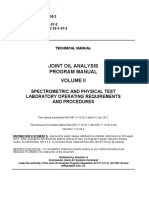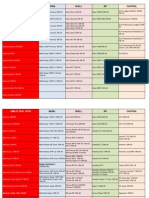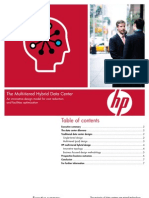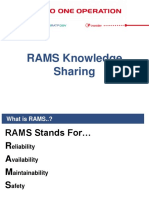Audit, Develop and Implement
Audit, Develop and Implement
Uploaded by
Vishal MadooCopyright:
Available Formats
Audit, Develop and Implement
Audit, Develop and Implement
Uploaded by
Vishal MadooOriginal Title
Copyright
Available Formats
Share this document
Did you find this document useful?
Is this content inappropriate?
Copyright:
Available Formats
Audit, Develop and Implement
Audit, Develop and Implement
Uploaded by
Vishal MadooCopyright:
Available Formats
Audit, Develop and Implement Completing an Audit and Implementing Changes to Boost Lubrication Program Performance In 2009, Trico
Services was contracted to complete an equipment lubrication audit of a large mill in the southeast that produces liner and corrugated material for containers. This audit was for roughly 2500 pieces of rotating equipment. Upon completion of the audit, Trico was to take the lubrication recommendations and input this data into the MAINTelligence software platform that the facility uses using to manage their plant lubrication programs. Outline Scope of Service The Scope of Service for this project was be broken into four phases. Phase I of this project would begin in the Pulp Mill area of this facility. The Pulp Mill area is comprised of the following sub-areas: Caustic Area, Tall Oil, Digesters and Pulp Mill general. Phase II was the Power House. Phase III was Paper Manufacturing consisting of three paper machines and Phase IV was the Chip Yard. Under our arrangement the following services were provided: Verify lubrication requirements for all equipment in their specific area. Verify that correct lubricants are being used for each point identified. Establish the correct frequency for re-lubrication. Create an electronic database that would be used to house the lubrication audit and will facilitate the development of a living lubrication database. Tag equipment with a bar code used for accessing hand held lubrication routes manage by the MAINTelligence software. Upon completion of the lubrication audit in each area, the data was transferred into the MAINTelligence software. Under our agreement the following services were provided: 1. Create appropriate reading type (inspections) for equipment that would be inspected. 2. Build lubrication points into the MAINTelligence database; create detailed outage and nonoutage lubrication routes for the designated areas. 3. Mentor the local system administrator on the following:
Setting up the inspection routes (see Figure 1). Creating inspection specifications in the database. Scheduling the inspections for a specific time period. Scheduling and conducting any remedial action needed to eliminate the exceptions. General operation of the MAINTelligence software.
4. Mentor the area lubrication technicians in lubrication best practices along with MAINTelligence operations.
Figure 1 - Inspection Cycle Workfl ow Lubrication Audit Overview Purpose - The equipment audit was performed to obtain knowledge of the equipment, its internal design, the system design, and the current operating and environmental conditions. Failure to gain full understanding of the equipment operating needs and conditions undermines the technology. This information was used as a reference to set equipment targets and limits while supplying direction for future maintenance activities. The information was placed in an automated lube list that is accessible to all plant personnel via the local intranet. There were approximately 2,500 lubrication assets audited during this process. Below is a list of other criteria that were evaluated per asset. Equipment Mission Criticality - Safety, environmental concerns, historical problems, reliability, downtime costs and repairs must all be considered when determining the equipment included in the program, the frequency and the selections of all health monitoring tests. Equipment Component and System Identification - Collecting, categorizing and evaluating all design and operating manuals including schematics are required to understand the complexity of modern equipment. OEMs assistance in identifying the original bearings, wear surfaces and component metallurgy will take the guesswork out of setting targets and limits and also aid in future troubleshooting. Equipment nameplate data with accurate model and serial numbers allow for easy identification by the manufacturer to aid in obtaining this information. Operating Parameters - Equipment designers and operating manuals reflect the minimum requirements for operating the equipment. These include operating temperature, required lubricant needs, pressures,
duty cycles and filtration to name a few. Operating outside the recommended values could require modifications and/or additions to the system to allow the component to run within an acceptable range. Operating Equipment Evaluation - A visual inspection of the equipment is required to examine and record the components used in the system including filtration, breathers, coolers, heaters, etc. This inspection should also record all operating temperatures and pressures, duty cycle times, rotational direction and speeds, filter indicators, etc. Temperature reading of the major components is required to reflect the component operating system temperature. This information verifies that OEM supplied equipment is still in operation and reflects the present operating characteristics of the equipment. Operating Environment - Hostile environments or environmental contamination in most cases is not taken into consideration when OEMs establish operating parameters. These conditions can influence lubricant degradation, eventually resulting in damaged equipment. All environmental conditions such as mean temperature, humidity and all possible contaminants must be recorded. Installing Tags and Barcoding Assets The decision was made to scan barcodes at each inspection point. Scanning the barcode automatically records the identification of the maintenance technician, and the time and date stamp of when the inspection is completed. This is helpful for regulatory compliance. When a maintenance technician walks up and scans the barcode, the corresponding inspection is brought up on the data collector. We were furnished with an equipment list that we scrubbed for accuracy during our lubrication audit. Once the list was verified, the data was provided to our production personnel in Pewaukee, Wisconsin where the labels were printed and the tags put together (see Figure 2).
Figure 2 - Example of Tag with Bar Code How Lubrication Audit Augmented Hand Held Technology (MAINTelligence) At the time, the plant was using paper based lubrication inspections. These inspections were usually completed on schedule. However, using the information from these inspections as a tool for work identification and triggering corrective work orders was fairly difficult. The paper forms were hard to sort through. Often, the needed form would be stacked deep on the inspection clipboard, so finding the noted exceptions either took a considerable amount of time or just couldnt be done. By completing the lubrication audit on the rotating equipment assets in the plant, the initial verification and leg work had been completed for a successful implementation. There is no question that lubrication inspection procedures can be carried out using paper checksheets. However, it was felt that implementing the lubrication rounds using an automated approach would resolve the problem of incomplete work identification. The benefits of automated lubrication inspection rounds are: Implementing automated lubrication programs are easier and more efficient. Increases the accuracy and consistency of collected data. Immediate feedback is available to the operators when assessing the asset. Exceptions are indicated immediately to maintenance and reliability staff. The primary goal of collecting the data electronically is to capture this data into a searchable database automatically, without having the need for data entry from the paper inspection forms. This allows the information collected from inspections to be sorted and flagged as exceptions, and used to immediately generate corrective work orders.
Implementation Costs Many first time purchasers of software encounter severe sticker shock regarding the cost of implementing maintenance software systems. The reality is that the cost of implementation will typically range from 1:1 to 2:1 compared to the cost of the software. In this case the cost of implementing the software was far less since the software was already loaded on the network CITRIX server. Trico was able to take the data from the equipment lubrication audit, immediately input that data into the MAINTelligence software and then create the lubrication routes for the plant. Implementation for this project came in on budget as planned, and at the customers request, an additional week of work was added to the end of the project. This work was scheduled as a four phase project completed in about 70 days. Maintenance Cost Reductions Maintenance costs are the second highest component of operating expenses (after utilities), and nearly every industry is working to control these expenses for at least a couple of reasons. First, the rising costs of electricity,gas, and even water and sewer charges are pulling funding away from maintenance activities. Second, economic times are difficult right now, and most companies have been requested to make budget reductions.Everyone understands that you have to keep paying the electric bill, but there is a perception that you can cut the maintenance costs at least for a while. Many companies are doing the same types of maintenance with lower funding levels. With lower maintenance funding, the facility conditions deteriorate and the productivity of the workforce suffers. Also, poorly maintained equipment will use more energy and overall expenses will rise even faster. This can be a difficult cost spiral from which it is very difficult to recover. A better strategy in these difficult budget times is to increase the productivity of your maintenance workforce. Nearly every organization with which we have worked either supplements its staff with contracted resources or utilizes overtime by its regular staff to complete their maintenance activities. By getting more work done with your own staff, you will be able to reduce the need for contractors, reduce the need for overtime, or both. How can one increase the productivity of a maintenance workforce with a very short return-oninvestment? Consider implementing handheld devices for the maintenance workforce.It is one of the maintenance Best Practices identified by many industry experts. Fortunately, the companys management recognizes this and is implementing this across their entire organization. They realize that the devices can increase efficiency and productivity of their staff. By doing this they can reduce their costs and operate more efficiently.
Currently the facility is in the infancy stage of operating their handheld units and metrics are in place to track work efficiency and other related maintenance metrics directly relating to the use of handhelds. The following is a simplified list of potential key indicators that could be used as the lubrication program matures: Reduce Lubricant Costs - In a lubrication optimization program, the goal is to minimize the purchase of new lubricants through the consolidation of products, the elimination of time-based oil changes, and minimizing of waste and leakage. When properly done, all of these measures should have a measurable effect on the dollars being spent annually on lubricants. Improve Compliance to Scheduled Lubrication PM Tasks - All lubrication tasks, from the daily level checks, sampling for oil analysis, regreasing, top-ups, and scheduled oil changes, need to be scheduled activities. Measuring the percent conformance of PMs that were scheduled and completed to that of PM tasks that were not completed within the required parameters (time, date, frequency, etc) allows for a quick, accurate view of PM compliance. Adjust or Redefine Analysis Alert or Alarm Limits - Initial temperature, pressure and oil analysis alarms must be reviewed to ensure that the original target values are correct and that they appropriately reflect the equipment specific operating condition of the equipment components. This is often accomplished by incorporating feedback from the maintenance activities and using lessons learned resulting from root cause analyses of failed components. Improve Equipment Reliability - Performance indicators that relate to the equipment reliability and availability remain significant to the effectiveness of the lubrication program. The goal is to minimize or reduce the number of lubrication-related equipment failures or significant events but this remains difficult to determine if the actual root cause of an anomaly is not correctly identified. Improve Oil Cleanliness Levels - It has been well documented that by improving the cleanliness levels of a lubricant, it will have a direct effect on the life of the component. Improvement in handling, storage, dispensing and filtration methods will assist in reducing the acceptable cleanliness levels, which results in improved equipment reliability with the associated reduction in maintenance costs. Tracking and Trending Lubricant Disposal Costs - Understanding the total consumption, leaks, top-ups, and oil changes, will allow a companys efforts and behaviors to be better focused toward the effective implementation of the lubrication program. Other Key Performance Indicators to Consider Breakdown, Availability interruptions, Failures
O.E.E. (Overall Equipment Effectiveness) TTPM: Time To Preventive Maintainance, as a % of total time Preventive, Corrective, Scheduled Maintenance % of work scheduled % of work type backlog Maintenance Costs Maintenance cost as % of asset value Ratio of unplanned to total maintenance cost Effectiveness Number of jobs planned but not yet performed Number of jobs not started at planned time/date Efficiency MTBF: Mean-Time-Between-Failures MTTR: Mean-Time-To-Repair Production losses due to unplanned downtime Production losses due to planned/preventive maintenance Regardless of the indicators that are used, the purpose should be to help quantify the maintenance effectiveness and impact on the companys bottom line through equipment and facility availability, defined in terms that are meaningful to their organization. Next Steps Operator Basic Care Program - Currently there is a vision within the organization to establish a comprehensive program to ensure that operators, as the owners of equipment, understand equipment condition at all times by cleaning, lubricating, adjusting, inspecting, and making simple repairs to maximize uptime and reduce unplanned events to zero. The company wants to use the MAINTelligence platform to house all of these inspections for their operators. We have been asked to provide a proposal that would outline all the scope of work and associated cost in developing the Operator Basic Care program at the facility. Lubrication Program follow-up - As the lubrication program (MAINTelligence) matures at the facility we are currently focusing our direction on other opportunities within their lubrication program. We are currently working on installing turnkey lubrication storage & handling unit in the Pulp Mill and have a plan to install lubrication storage & handling units in the other areas of the mill. We have also focused
our efforts in addressing lubrication best practices when it comes to installing and using desiccant breathers. We have also identified and addressed the need for proper lubricant filtration, proper sampling ports for an effective oil analysis program along with establishing the proper cleanliness codes and test slates that should be performed per family type of equipment. Our plan is to review the current lubrication routes after a 12-month cycle to ensure we have the correct frequency based on the operating and environmental conditions within the facility and adjust as needed. Our goal is to help the facility follow all of the best practices when it comes to lubrication excellence. Paul Dufresne is an industry leading expert in the area of plant lubrication and equipment reliability. Paul is a Distinguished Military Graduate from the University of Central Florida and holds a Certified Lubrication Specialist (CLS) rating from the Society of Tribologists and Lubrication Engineers; Certified Maintenance Reliability Professional (CMRP) rating from the Society of Maintenance and Reliability Professionals. The article was written by Paul while he was employed with Trico. Paul is now the Operations Excellence Specialist with Georgia Pacific. Paul can be reached at paul.dufresne@hotmail.com
You might also like
- Safety Integrity LevelDocument1 pageSafety Integrity Leveljohn_tiger100% (8)
- Article - Lubrication at BHP SteelDocument5 pagesArticle - Lubrication at BHP SteelzuhdisulaemanNo ratings yet
- Your Benefit: Optimised Lubrication Management: Enhanced Reliability and Efficiency in Your PlantDocument2 pagesYour Benefit: Optimised Lubrication Management: Enhanced Reliability and Efficiency in Your PlantVelibor Karanovic100% (1)
- Graco G1 AutolubeDocument36 pagesGraco G1 Autolubewahidahadit75No ratings yet
- Splash Lubrication PDFDocument32 pagesSplash Lubrication PDFRajender KumarNo ratings yet
- Viscosidades KluberDocument23 pagesViscosidades KluberRCMNo ratings yet
- Shell Turbo T46 PDFDocument2 pagesShell Turbo T46 PDFdionisio emilio reyes jimenezNo ratings yet
- 08 Used Oil Analysis NaDocument50 pages08 Used Oil Analysis NaІнвент ГрупNo ratings yet
- OMA Reading PDFDocument2 pagesOMA Reading PDFSantos Junnior Hipolito SandovalNo ratings yet
- Maintenance & Reliability Initiatives: Intuitive & Common Sense Software Solutions ForDocument16 pagesMaintenance & Reliability Initiatives: Intuitive & Common Sense Software Solutions ForbwelzNo ratings yet
- Copia de Petrobras Marine Lubricating Oils Equivalent ListDocument5 pagesCopia de Petrobras Marine Lubricating Oils Equivalent Listeddy1588No ratings yet
- 87 - Glossary of TermsDocument28 pages87 - Glossary of TermsceljkoNo ratings yet
- Lubrication Management System AuditDocument10 pagesLubrication Management System AuditMartin MendozaNo ratings yet
- Design Engineer's Guide - Selecting A Lubricant For Ball ScrewsDocument10 pagesDesign Engineer's Guide - Selecting A Lubricant For Ball ScrewsDat RomanNo ratings yet
- Aceites Lubricantes para Motores Diesel Sep-2015Document28 pagesAceites Lubricantes para Motores Diesel Sep-2015Carlos Andres BonillaNo ratings yet
- Food Grade Lube From Each BrandDocument6 pagesFood Grade Lube From Each BrandCindy OrangeNo ratings yet
- Perumbavoor Plywood Manufacturers PDFDocument19 pagesPerumbavoor Plywood Manufacturers PDFAnonymous YnjlpKPNo ratings yet
- Lubrication Program Development LPDDocument27 pagesLubrication Program Development LPDPatrick Fo100% (1)
- NLGI Grease Technical DocumentDocument10 pagesNLGI Grease Technical Documentho-faNo ratings yet
- ACEA European Oil Sequences 2016Document15 pagesACEA European Oil Sequences 2016David PomaNo ratings yet
- Geared Up For SuccessDocument32 pagesGeared Up For Successrashm006ranjanNo ratings yet
- Reprot On TrainingDocument36 pagesReprot On TrainingMd.Mahbub MorshedNo ratings yet
- Kluber Lubricants For Gas Compressors ManualDocument24 pagesKluber Lubricants For Gas Compressors ManualJon GNo ratings yet
- TribiologyDocument36 pagesTribiologySavindra SilvaNo ratings yet
- Mobil Machine Tool LubricantDocument66 pagesMobil Machine Tool LubricantManjit Malvi100% (1)
- Oil Filtering Whitepaper 2017Document10 pagesOil Filtering Whitepaper 2017Brayan MejiaNo ratings yet
- DES-CASE - Breather White Paper - SmallDocument14 pagesDES-CASE - Breather White Paper - SmallGonzalo Enrique Caceres GarridoNo ratings yet
- Lubrimist Model Ivt PDFDocument2 pagesLubrimist Model Ivt PDFLluhiNo ratings yet
- Mobil Univis N68 DatasheetDocument3 pagesMobil Univis N68 Datasheetphankhoa83-1100% (1)
- How To Choose The Right LubricantDocument2 pagesHow To Choose The Right LubricantHesham MahdyNo ratings yet
- Comparativo STLE and ICMLDocument3 pagesComparativo STLE and ICMLPatricia MenaNo ratings yet
- Machinery Lubrication EbookDocument14 pagesMachinery Lubrication Ebookganeshji@vsnl.comNo ratings yet
- Wear Particle Analysis of OilDocument7 pagesWear Particle Analysis of OilChandan KumarNo ratings yet
- Selecting Target ISO Cleanliness CodesDocument4 pagesSelecting Target ISO Cleanliness CodesluaguNo ratings yet
- How To Choose Your GreaseDocument15 pagesHow To Choose Your Greasedhavit wijayantoNo ratings yet
- Eaton Internormen Condition Monitoring SystemsDocument16 pagesEaton Internormen Condition Monitoring SystemsEaton FiltrationNo ratings yet
- LT32599 10Document38 pagesLT32599 10Angela Bailey100% (1)
- 60 Question For Lube SuppliersDocument12 pages60 Question For Lube SuppliershungNo ratings yet
- Chapter 6 LubricationDocument24 pagesChapter 6 Lubricationchala nigussieNo ratings yet
- Military Joint Oil Analysis Manual Vol IIDocument408 pagesMilitary Joint Oil Analysis Manual Vol IIVijay HanagandiNo ratings yet
- Bentone 52Document2 pagesBentone 52mgamal1080No ratings yet
- Afton Chemical HiTEC-317 - PDSDocument2 pagesAfton Chemical HiTEC-317 - PDS1mmahoneyNo ratings yet
- Oil Condition Monitoring BrochureDocument4 pagesOil Condition Monitoring BrochureLubrexcel LubrifiantiNo ratings yet
- Cement Industry: Reliable & Cost Saving LubricantsDocument8 pagesCement Industry: Reliable & Cost Saving LubricantsJulian Dario Galarza InsfranNo ratings yet
- Flushing and The Voice Within Your OilDocument4 pagesFlushing and The Voice Within Your OilHunab379No ratings yet
- Bechem CoolantsDocument1 pageBechem CoolantsChung LeNo ratings yet
- Gearbox LubricationDocument10 pagesGearbox LubricationS.Prabakaran S.PrabakaranNo ratings yet
- INDUSTRIAL LUBRICANTS-misr Petroleum PDFDocument17 pagesINDUSTRIAL LUBRICANTS-misr Petroleum PDFIslam FawzyNo ratings yet
- Tribology-Key To Proper Lubricant Selection: White PaperDocument6 pagesTribology-Key To Proper Lubricant Selection: White PaperHarrison IziyonNo ratings yet
- CetvelDocument17 pagesCetvelmehmetaliozgur100% (1)
- Synthetic Lubricants Cross-Reference Guide: Klüber Lubrication Texas, L.P. Dba Summit Industrial ProductsDocument18 pagesSynthetic Lubricants Cross-Reference Guide: Klüber Lubrication Texas, L.P. Dba Summit Industrial ProductsmehmetaliozgurNo ratings yet
- Shovel Lubrication PDFDocument2 pagesShovel Lubrication PDFSounak SasmalNo ratings yet
- FH51 HydraulicFluid PDFDocument1 pageFH51 HydraulicFluid PDFSam GiovanniniNo ratings yet
- Shell Turbo T PDFDocument3 pagesShell Turbo T PDFrehmanNo ratings yet
- Accessories For Lubrication Systems: Product CatalogueDocument28 pagesAccessories For Lubrication Systems: Product CatalogueArtem100% (1)
- Grease 082504referenceDocument6 pagesGrease 082504referencesmhea123No ratings yet
- EB1605 Breather Ebook FinalDocument15 pagesEB1605 Breather Ebook FinalArun PrakashNo ratings yet
- Fluid Analysis for Mobile Equipment: Condition Monitoring and MaintenanceFrom EverandFluid Analysis for Mobile Equipment: Condition Monitoring and MaintenanceNo ratings yet
- The Death of Reliability: Is it Too Late to Resurrect the Last, True Competitive Advantage?From EverandThe Death of Reliability: Is it Too Late to Resurrect the Last, True Competitive Advantage?No ratings yet
- Preventing Turbomachinery "Cholesterol": The Story of VarnishFrom EverandPreventing Turbomachinery "Cholesterol": The Story of VarnishNo ratings yet
- C10338815 PDFDocument8 pagesC10338815 PDFLuis LopezNo ratings yet
- Assignment 4Document5 pagesAssignment 4Shashwat PandeyNo ratings yet
- Mapping The Total Value Stream: A Comprehensive Guide For Production and Transactional ProcessesDocument7 pagesMapping The Total Value Stream: A Comprehensive Guide For Production and Transactional ProcessesKisNo ratings yet
- Opmanual Model 280pdDocument34 pagesOpmanual Model 280pdmexx_05No ratings yet
- User Needs - Plcor Dcor Scor Ccor - Hawley - 6-8-12 v1Document42 pagesUser Needs - Plcor Dcor Scor Ccor - Hawley - 6-8-12 v1Kariem DarwishNo ratings yet
- Brochure Scania Long Distance General Volume TempDocument16 pagesBrochure Scania Long Distance General Volume TempMioMaulenovoNo ratings yet
- Maintworld 4 - 2017Document52 pagesMaintworld 4 - 2017Yassine MESSAOUDNo ratings yet
- Life Management and Extension StudiesDocument6 pagesLife Management and Extension StudiesAhmed SalmanNo ratings yet
- TQM - TPMDocument11 pagesTQM - TPMPandi ANo ratings yet
- Reliability, Availability, Maintainability, Safety (RAMS) and Life Cycle Costs (LCC)Document88 pagesReliability, Availability, Maintainability, Safety (RAMS) and Life Cycle Costs (LCC)DimSol100% (3)
- 4059 MultiHybridWPDocument8 pages4059 MultiHybridWPFarhan R. PatelNo ratings yet
- Advantages of Aeroderivatives IAGT 206 - Final - PaperDocument15 pagesAdvantages of Aeroderivatives IAGT 206 - Final - PapermvanzijpNo ratings yet
- State of Michigan SaaS AgreementDocument36 pagesState of Michigan SaaS AgreementBB79No ratings yet
- Aircraft SystemsDocument81 pagesAircraft Systemsaks01mehraNo ratings yet
- Sec VIII-Q Paper Maintainability & Availability CRE Primer 2002Document14 pagesSec VIII-Q Paper Maintainability & Availability CRE Primer 2002Raj KumarNo ratings yet
- Indent Verification of Labour RoomDocument4 pagesIndent Verification of Labour RoomRajeshwariNo ratings yet
- Maintenance ManagementDocument112 pagesMaintenance ManagementNiveditaKumari100% (11)
- (PCM) - Aplng Upstream Phase 1 - Custody Metering Skids - Technical SpecificationDocument37 pages(PCM) - Aplng Upstream Phase 1 - Custody Metering Skids - Technical SpecificationChrisNo ratings yet
- ServiceMax Power and Utility FinalDocument4 pagesServiceMax Power and Utility FinalPriscila GarciaNo ratings yet
- Syllabus OF VII & VIII Semesters B.E. Industrial Engineering & Management 2017-18Document40 pagesSyllabus OF VII & VIII Semesters B.E. Industrial Engineering & Management 2017-18Joven CastilloNo ratings yet
- FDD LTE Key Performance Indicators Description GuideDocument48 pagesFDD LTE Key Performance Indicators Description GuidehammadleoNo ratings yet
- Ieee 762-2006 - KpiDocument78 pagesIeee 762-2006 - KpidiegovalenzuelaNo ratings yet
- RAMS Knowledge SharingDocument29 pagesRAMS Knowledge SharingJAYNo ratings yet
- The TPM Guide: Total Productive MaintenanceDocument38 pagesThe TPM Guide: Total Productive MaintenanceRudy CruysbergsNo ratings yet
- Use Iot To Advance Railway Predictive Maintenance WhitepaperDocument28 pagesUse Iot To Advance Railway Predictive Maintenance Whitepaperdwi hananto bayu aji100% (1)
- MP Avt 144 04Document14 pagesMP Avt 144 04DaveNo ratings yet
- Advanced Maintenance Management: Jose K Puthur RCBSDocument178 pagesAdvanced Maintenance Management: Jose K Puthur RCBSSharath PanickerNo ratings yet
- TPMDocument41 pagesTPMArun Narayanan100% (1)
























































































